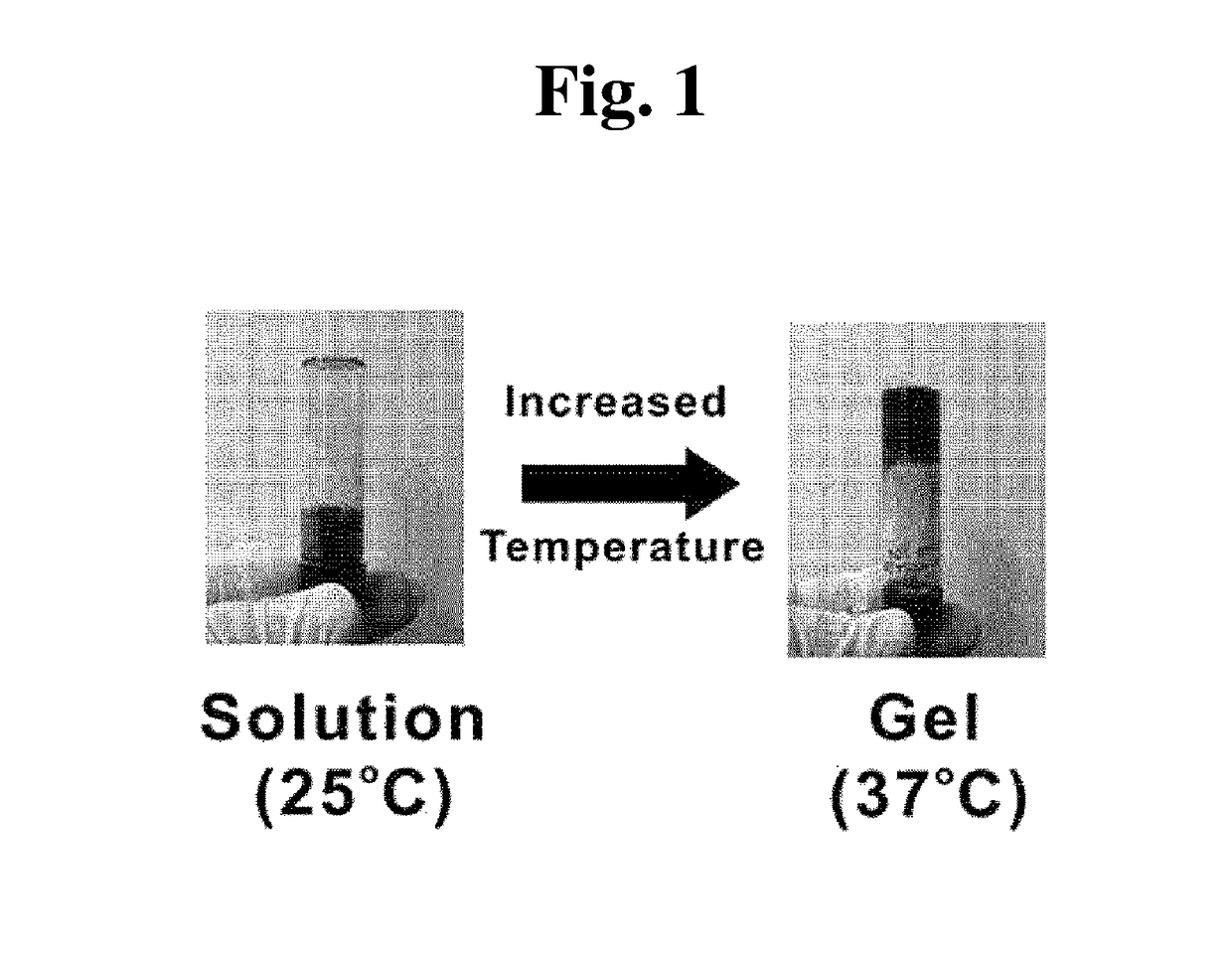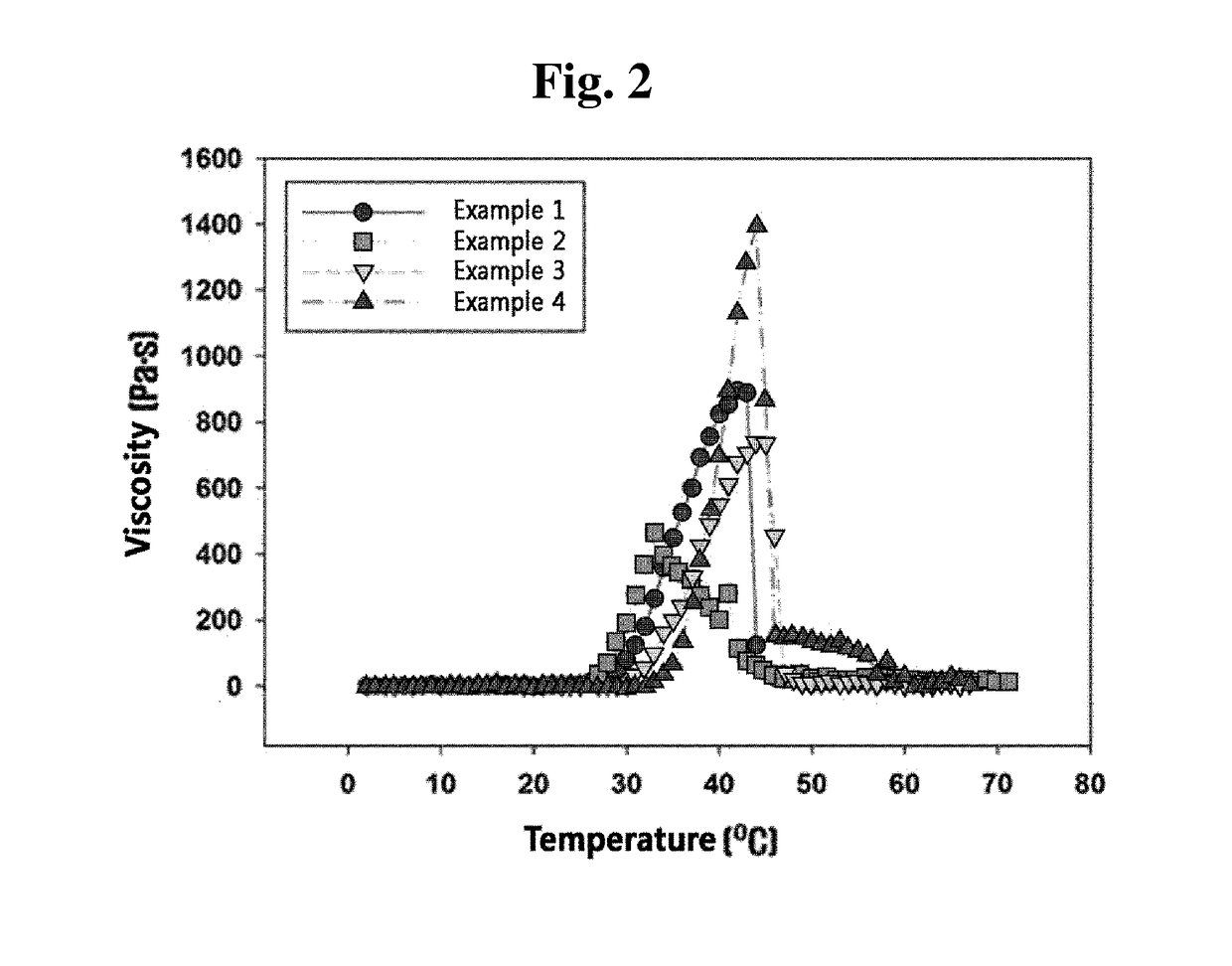Phosphazene-based polymer for tissue adhesion, a method for preparing the same, and use thereof
a tissue adhesion and phosphazene technology, applied in the field of phosphazene-based polymers, can solve the problems of frequent reapplication of tissue adhesion substances, difficulty in clinical application of temperature-sensitive hydrogels, and deterioration of adhesiveness, so as to improve tissue adhesion and prevent infection. , the effect of less sensitive to moistur
- Summary
- Abstract
- Description
- Claims
- Application Information
AI Technical Summary
Benefits of technology
Problems solved by technology
Method used
Image
Examples
example 5
hange of Phosphazene-Based Polymer Containing Catechol Group According to Temperature Change
[0145]The catechol group-containing phosphazene-based polymers according to Examples 1 to 4 were each dissolved in phosphate-buffered saline (pH 7.4) at 4° C. at a concentration of 10 wt %. Thereafter, the resultants were placed in a chamber of a viscometer (Brookfield DV-III+ Rheometer) equipped with the TC-501 automatic water distiller, and a sol-gel transition behavior was observed by setting a shear rate to 0.1 to 1.7 per second, and by raising a temperature by 0.04° C. per minute.
[0146]In FIG. 1, the state of the catechol group-containing phosphazene-based polymer at 25° C. and 37° C. according to Example 1 of the present invention was shown as photographs. As shown in FIG. 1, it was confirmed that the polymer of Example 1 of the present invention existed in a form where a solution is flowing at room temperature, but existed in a gel form at body temperature due to phase transition.
[0147...
example 6
Gel Amount of Phosphazene-Based Polymer Containing Catechol Group Depending on Time
[0151]In order to confirm the change in gel amount depending on time, the catechol group-containing phosphazene-based polymers according to Examples 1 and 2 of the present invention were each dissolved in phosphate-buffered saline (pH 7.4) at 4° C. at a concentration of 10 wt %. Thereafter, 200 μL of the resultants were injected into mice's backs. After the day of injection, day 1, day 3, day 7, and day 14, respectively, these mice were sacrificed in order to obtain the gel, and the gel was visually observed to evaluate the reduction rate.
[0152]As shown in FIG. 3, it was confirmed that although the amount of gel decreased with the lapse of time after injection into the body, the gel injected into the body effectively remained in the injected tissues even after 2 weeks.
example 7
hesion Ability of Phosphazene-Based Polymer Hydrogel Containing Catechol Group
[0153]In order to directly confirm a tissue-adhesion ability of the catechol group-containing phosphazene-based polymer according to the present invention, a hole was made on mice's livers to induce blood to flow out. Thereafter, the catechol group-containing phosphazene-based polymer solution according to Example 1 of the present invention was directly treated at the bleeding site, and the change in blood outflow amount was observed. Morphology of the damaged mice's livers treated with the catechol group-containing phosphazene-based polymer solution according to Example 1 of the present invention is shown in FIG. 4. In addition, the bleeding volume from the mice's livers treated with the catechol group-containing phosphazene-based polymer solution according to Examples 1 and 2 of the present invention was measured, and is shown in FIG. 5.
[0154]As shown in FIG. 5, it was confirmed that the bleeding volume ...
PUM
| Property | Measurement | Unit |
|---|---|---|
| temperature | aaaaa | aaaaa |
| temperature | aaaaa | aaaaa |
| temperature | aaaaa | aaaaa |
Abstract
Description
Claims
Application Information
 Login to View More
Login to View More - R&D
- Intellectual Property
- Life Sciences
- Materials
- Tech Scout
- Unparalleled Data Quality
- Higher Quality Content
- 60% Fewer Hallucinations
Browse by: Latest US Patents, China's latest patents, Technical Efficacy Thesaurus, Application Domain, Technology Topic, Popular Technical Reports.
© 2025 PatSnap. All rights reserved.Legal|Privacy policy|Modern Slavery Act Transparency Statement|Sitemap|About US| Contact US: help@patsnap.com



